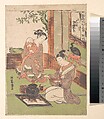Modern Versions of the twenty-four Paragons of Filial Piety: Guo Zhu
Isoda Koryūsai Japanese
Not on view
As his young wife watches raptly, a young man is taking boiling water with a bamboo ladle from an iron tea cauldron in a square hearth set into the tatami mat floor. Behind him a Chinese-style painting of a bird in bamboo is hung before a bird-shaped incense burner in the tokonoma alcove. This scene of domestic tranquility focused on the cauldron and other utensils of the formal tea ceremony (chanoyu) is in fact a witty parody of one of the moralizing tales propagated in Confucianism, the official ideology of the Tokugawa shogunate.
Guo Zhu, said to have lived in the second century A.D. in China, was so devoted to his aged mother that, finding himself unable to support his entire family, he persuaded his wife that they should bury their infant son to be able to feed her. As he was digging the grave, he uncovered a cauldron of gold, a just reward which saved him from a painful, extreme exercise of his filial piety. Such an urbane twist on a traditional theme is typical of the wit of Ukiyo artists and their Edo patrons, who chafed under the rigid morality espoused by the Shogunate. Koryūsai adopted the doll-like figures of his teacher Harunobu, adding a fresh robustness that prefigures the more realistic representations of the 1780s. The darkened mottling on the orange color is the result of oxidation of red lead, an effect sometimes used intentionally for architectural elements.
This image cannot be enlarged, viewed at full screen, or downloaded.

